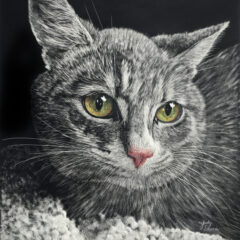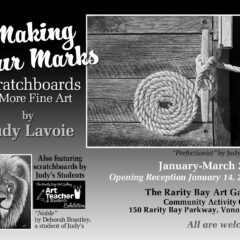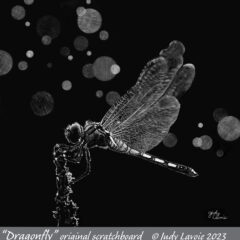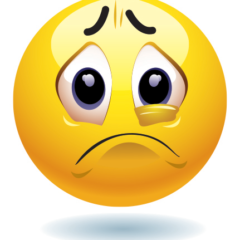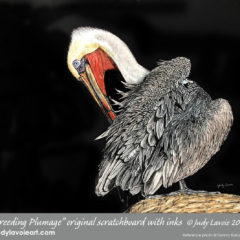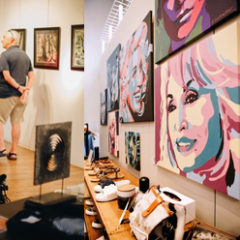
There is alway more to learn about creating art, and that’s part of my passion. I could be a forever student!
I recently complete a fabulous online workshop with a portrait artist whose work I have admired for years, Ali Cavanaugh. She is a master of creating exquisite watercolor portraits on white clay-coated Aquabord™ panels made by Ampersand Arts. I've used this combination of paints and surface for many paintings, primarily learning how to handle the unique qualities of watercolor on Aquabord by my own trial and error. This was the first time I’ve actually received instruction on painting portraits with this combination of media, and I learned some fabulous techniques from Ali.
The workshop format was unusual: participants were given access to three instructional videos created by Ali, to watch as often as desired during a 3-week window. During these videos she reviewed her tools and techniques from start to finish, and created a demo portrait. Two weeks into this workshop schedule Ali scheduled a live Zoom critique for all participants who wanted to submit their new artwork created using her methods, and this digital image had to be presented by Day 11. So-o-o-o-o there was a bit of a time crunch to create a new painting after watching her videos! Rushing is just one of my excuses for my first attempt, a portrait of “Julianna.”
I didn’t have 3 of the 6 colors Ali used for her demo painting (or even anything close to them), and I didn’t have the tiny synthetic round brushes (sizes 0 to 3) she used, so I had to ‘make do’ to create a workshop-based portrait to submit for the critique. I decided to use a limited palette of 3 colors I had. The best photo I could find for a reference was a black and white photo taken several years ago of my young beautiful friend Julianna, which I took with her permission from her Facebook page. I painted her portrait with watercolors on an 8” x 8” Aquabord panel, using ultramarine blue, burnt sienna, and nickel azo pigments. I felt I produced a good likeness and I got the values right but the painting didn’t really come together for me. But the deadline was looming so I declared it finished and submitted a digital image of "Julianna" for Ali's Zoom critique (photo #7 in my collage of "Julianna" in process is the image I submitted).
With 138 workshop participants (including 22 from outside the US), Ali only had time to briefly comment on each painting, and her remarks were mostly positive, never very critical. With my “Julianna” portrait on the screen, she said “This one is really interesting in the way it almost looks like a colorized black & white photograph - that’s what jumped out to me from the beginning. Excellent control on the Aquabord; really good modeling of the skin.” Well, she nailed me on the b/w photo reference, but otherwise her critique was positive. ANYWAY, I needed to give this a second try….
I ordered Ali's recommended brushes and the three colors which were missing from my stash and set up to start a new portrait. This time I used another Facebook swipe, a color photo of my great-niece Lily (grandbaby of my sister Jean, daughter of Molly and hubby Dave). I wanted to concentrate on the skin tones, especially since Julianna had ended up looking jaundice! I also selected a pose where I would spend minimum effort doing hair, mouth or clothing. The photo I chose also focused on her engaging eyes, features which are already within my comfort zone. So I proceeded to create my new color portrait of baby Lily on a 6” x 6” Aquabord panel. I painted with the same 6 paint colors as Ali had used in her demo, and did the entire painting with a size 0 round brush. As Ali had mentioned in her workshop, the slightly textured Aquabord surface is tough on brushes, especially when using her method of making a series of small strokes of paint, almost like filling in an area with colored pencils. See my color palette picture below, where I laid a new paintbrush (the one with the white bristles) next to the one I used; enlarge the image by clicking on it to see the lack of a point and shaggy hairs on the used brush.


With the new paints, brushes, and the luxury of time, I created my little portrait of Lily (shown at the top of this post).
I began by making a color swatch of the six watercolors I'd paint with, as I always do when starting a new painting with a different selection of colors. It helps to see the colors in full strength and watered down, and also to test how some of the hues mix into other colors. The bright turquoise was awkward to incorporate into skin tones, but Ali's use of that color added a striking element to her demo so I was determined to work with it.
You can see how I cropped the image close to Lily's face and fit it to a square format. My graphite sketch is minimal, and primarily guides me to where there are major value changes (ie. lights against darks.) Excess graphite can be erased away with a white rubber eraser or lifted off with a wet Magic Eraser. Ali's painting method is to start by covering the face with very light values first, only using dark values at this stage to define certain features before your sketch marks fade, such as for the eyes and nostrils. Once each painted area dries, Ali adds another layer of color, sometimes warm over cool or visa-versa. She repeats the process over and over to gradually build up the forms and add dimension, in a way which keeps the colors vibrant and creates an overall glow.
You can see I changed the background from the reference photo, letting the colors flow randomly and without the control used in applying color elsewhere - another of Ali's techniques. A few little scratches through the painted areas to reveal the white surface of the Aquabord added the finishing touches.
I was encouraged with my more satisfactory results in painting "Lily," and her mom and 'Gigi' were very complimentary. So I decided to revisit the Julianna painting, nervous that I might make it worse but ready to give it a try. I added and lifted paint (one of the many advantageous properties of using Aquabord), using some of the colors from Ali's palette and painting with the tiny brush this time. I darkened the background, totally repainted her lips, and gave her hair and skin tones more color - perhaps too much??? I am encouraged with the difference from the first attempt; my "finished" version is shown in #8 in the Julianna collage above. If I start it over from scratch, I think I could do even better.
Long story short, I learned a great deal from the workshop and from my attempts to apply what I learned. I surely will be doing more watercolor portraits on Aquabord, so stay tuned!

